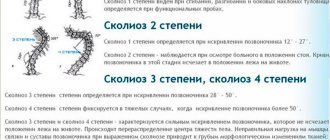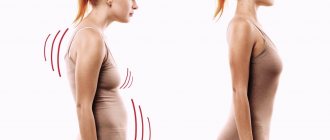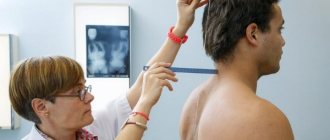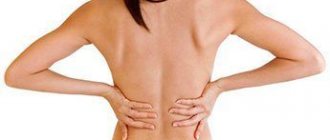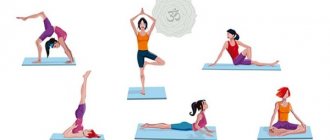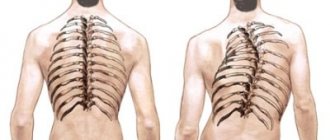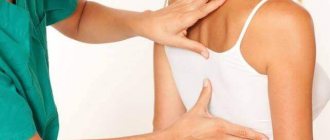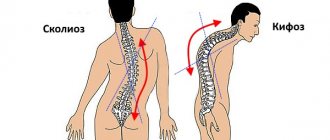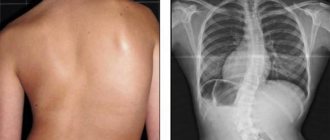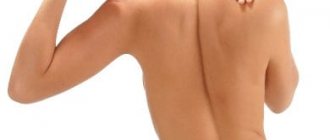Over the years, the diagnosis of scoliosis has become increasingly common, with the majority of new cases discovered occurring in children. Neither the right desks nor orthopedic mattresses contribute to a significant improvement in the situation. Therefore, scoliotic deformity of the spine is increasingly diagnosed during preventive examinations or when patients present with complaints of back pain.
About 30% of spinal diseases in children are due to scoliosis.
Most often, it is first detected in childhood or adolescence, and then can accompany a person throughout life if appropriate measures are not taken in a timely manner. Today, scoliosis, especially in the initial stages of development, can be successfully combated with conservative therapy and a complete restoration of the normal position of the spinal column can be achieved.
What is scoliosis
The human spine is conventionally divided into 4 sections: cervical, thoracic, lumbar and sacral. Each of them has physiological curves: lordosis (inward bending) in the lumbar and cervical regions, as well as kyphosis (outward protrusion) in the thoracic and sacral regions.
Scoliosis is a persistent deformity of the spine in which it bends sideways in relation to the central axis. In this case, the deformation does not affect a separate part of the spinal column, but most often each of them. Scoliosis is characterized by increased natural lordosis and kyphosis. Rotation of the vertebral bodies is also observed, which provokes changes in posture of varying degrees of severity, changes in the line of the shoulders and pelvic bones.
In most cases, the main curvature occurs in the lumbar region. In this case, the rest of the ridge is also subject to compensatory deformation. Scoliosis in any form leads to disruptions in the functioning of almost all body systems, since organs are displaced from their natural positions, which, of course, affects the quality of their functioning.
Most often, scoliosis is detected in children or already in adolescence, i.e., during the periods of the most active growth of the child. Growth spurts peak at ages 4–6 and also at ages 10–14. It is these periods that are considered the most critical, so parents should not neglect preventive medical examinations of children during these time periods that are important for the proper formation of the spine.
Do not confuse poor posture with scoliosis. If in the first case we are talking about a “bad habit”, then in the second we are talking about a disease that requires qualified complex treatment.
Spinal deformity can develop in adulthood and also progress. But more often it is a consequence of the lack of timely intervention at the time of initial formation, i.e. in childhood or adolescence.
Expert Opinion of a Doctor
The earlier a scoliotic curvature is found, the easier it is to correct it with the help of exercise therapy complexes, which are often neglected by parents.
Personal: Udovenko Bogdan Viktorovich
Orthopedist, chiropractor, vertebroneurologist, osteopath
Experience: More than 20 years
Ask a Question
Forecast
The prognosis of scoliosis in children depends on a combination of signs , including primarily anamnestic, clinical and radiological aspects. The earlier symptoms of severe scoliosis first appear in a child, the greater the risk that the disease will progress.
In children, the curvature reaches its maximum development by adolescence and stabilizes after complete ossification of the apophyses (bone protrusions) of the vertebrae. With timely detection of the disease at stages 1 and 2, and correctly chosen tactics of conservative therapy carried out until the end of growth, scoliosis in children and adolescents has a very favorable prognosis.
There is currently no method with a pronounced effect for the treatment of scoliosis diagnosed in adults. Correction of the spine and muscle corsetry is carried out through orthopedic measures. In cases where measures aimed at stabilizing the curvature do not produce results, surgical treatment is indicated.
Causes and types of scoliosis
A number of factors can provoke spinal deformity. The main division into types is due to the presence of axial twisting of the vertebrae, which causes other severe skeletal deformities. In such cases, a structural form of scoliosis is diagnosed. If such changes are absent, and the patient exhibits only a lateral curvature of the spine in one department or another, they speak of a non-structural form of the disease, which is characterized by a milder course.
There is also a distinction between congenital and acquired scoliosis. The most common form is acquired over the course of life, which can occur in response to various causes.
Acquired forms of scoliosis
The most famous and well-studied is the so-called school scoliosis. It occurs as a result of:
- prolonged sitting in an incorrect position;
- deficiency of a number of minerals in the body necessary for proper bone formation (resulting from imbalanced nutrition);
- being overweight;
- weakness of the back muscles;
- blows to the spine;
- uneven distribution of load on the back, for example, wearing a backpack on one shoulder.
Separately, neurogenic scoliosis is distinguished, which occurs in response to abnormalities in the functioning of the nervous system. It often results from:
- cerebral palsy;
- neurofibromatosis;
- polio;
- myopathies of various types;
- spastic paralysis;
- syringomyelia.
Scoliosis can be a consequence of rickets, which is most common in young children. The disease is caused by a deficiency of vitamin D in the body, which leads to decreased muscle tone and bone deformation.
There are also static and functional types of scoliosis. They are the result of disorders of the musculoskeletal system and inflammatory processes in the internal organs, respectively.
Congenital scoliosis
Sometimes the pathology is caused by hereditary disorders. This:
- congenital fusion of vertebrae with each other or the formation of extra, underdeveloped vertebrae;
- fusion of ribs;
- violations of the formation of arches and processes of the vertebrae.
In such situations, congenital scoliosis is diagnosed. It is usually detected during the first year of a child's life. The disease progresses slowly.
The birth of children with developmental pathologies can be caused by a woman suffering from viral diseases, severe stress, or taking certain medications during pregnancy.
A separate category is dysplastic scoliosis, diagnosed in children 3–6 years old. It is typically characterized by the presence of developmental anomalies in the area of the sacral and lumbar spine, which leads to disruption of metabolic processes both in the vertebrae themselves and in their intervertebral discs. Therefore, the disease is characterized by rapid progression and severe course. This is observed when:
- sacralization is a hereditary feature consisting in an increase in the number of sacral vertebrae and a decrease in the number of lumbar vertebrae);
- lumbarization is also a congenital pathology, in which, unlike sacralization, there is an increase in the number of lumbar vertebrae and a decrease in the number of sacral ones;
- underdevelopment of the last lumbar or first sacral vertebra (L5 or S1);
- non-fusion of the spinal arches.
Today, the true causes of scoliosis in approximately 80% of cases remain unclear. In such situations they talk about idiopathic scoliosis. It is more common in girls.
Prevention
Primary prevention of postural disorders comes down primarily to eliminating modifiable risk factors:
- Ergonomics of the workplace and control of body posture while sitting (especially when working at a computer).
- Full motor activity.
- Rational physical activity.
- Body weight control.
- Correct selection of shoes. Shoes with heels greater than 3 cm are not recommended.
- Using an orthopedic mattress/pillow for night sleep.
- Control over uniform/correct load on the spine when carrying bags, briefcases, backpacks.
- Timely correction of visual/hearing impairment, flat feet, and consequences of skeletal injuries.
- Swimming.
- Balanced diet.
Degrees and forms of scoliosis
During the course of the disease, there are 4 degrees that describe the severity of the curvature of the ridge:
- Grade 1 – the spinal column deviates from the normal axis by no more than 10°. This can be considered as a variant of the norm, since today such a deformation is present in almost every person. Curvature is detected exclusively using x-rays. It does not require serious medical intervention, but still needs constant monitoring so as not to miss the moment of progression of the deformity.
- 2nd degree – the angle of deviation of the spine is 10–25°. A qualified orthopedist or vertebrologist can notice such changes visually and recommend that the patient undergo complex conservative treatment to eliminate them.
- 3rd degree - the spine “goes” to the side by more than 25°, but still less than 40°. At the same time, a scoliotic hump begins to form, the shape of the chest changes, and the functioning of internal organs is seriously disrupted.
- 4th degree – the degree of deformation exceeds 41°. Patients experience severe pain and cannot stand, sit, or walk for a long time. All internal organs suffer greatly, and a large hump forms. It is possible to help patients in such situations only through surgery.
By the way, with 2 or more degrees of scoliosis, an exemption from conscription into the RF Armed Forces is given.
In 80% of patients, the angle of curvature of the spine is less than 20 °. In such situations, it is recommended to pay attention to the problem and take measures to solve it, since over the years, under the influence of physical activity and a number of other factors, the deformation can worsen up to degree 4. And this is associated with severe pain, the need to constantly wear a rigid orthopedic corset and an urgent need for surgical intervention.
Depending on which parts of the spine are involved in the pathological process and the direction of curvature, there are 4 forms of scoliosis:
- C-shaped - the spine is deformed in an arched manner in one of the sections, which is often a consequence of the work of compensatory mechanisms, which are activated, for example, when there is a large difference between the lengths of the legs. It can be left- or right-sided, but in any case it belongs to the group of non-structural scoliosis, i.e. it is not accompanied by rotation of the vertebrae.
- S-shaped - manifested by the presence of 2 arches at the same time, one of which is present in the thoracic region, and the second in the lumbar region. Most typical for teenage girls.
- Z-shaped is the most severe form of the disease, in which curvature of the spine is observed simultaneously in three of its parts.
- Kyphoscoliotic – the spine is deformed both in the lateral and frontal projections. Therefore, curvature to the side is often present in the area of the lumbar vertebrae, and curvature forward or backward in the chest, which leads to serious deformations of the chest and noticeable stoop.
Symptoms
The nature of the manifestations of the disease is determined by its type, form and degree. Scoliosis may include:
- headache;
- asymmetrical position of the shoulders and shoulder blades;
- curvature of the chest;
- breathing problems, shortness of breath;
- lower back pain;
- one-sided back muscle tension;
- hump formation;
- change in posture, stoop;
- fast fatiguability;
- disorders of the digestive system and other disorders.
Often, even with minor changes in the position of the spine, acute back pain occurs, which can radiate to the limbs and other parts of the body. Their cause often lies in the infringement of nerves by bone structures or modified intervertebral discs. This leads to a decrease in the quality of conduction of bioelectric impulses along the nerves from the spinal cord to the corresponding organs.
As a result, their work cannot be fully controlled by the nervous system, which results in the occurrence of disturbances in their functioning, and over time, the development of organic disorders. This, in combination with the negative effect of scoliotic deformity of the ridge, quickly leads to the occurrence of diseases of the respiratory system, heart, kidneys, liver, stomach and other abdominal organs.
Moreover, which organs suffer more directly depends on in which part of the spine the curvature is observed and its degree. Thus, with deformation of the thoracic spine and infringement of the nerves extending from the spinal cord in this area, there may be disturbances in the functioning of the bronchi, lungs, liver, pancreas, genitals, etc. This manifests itself:
- shortness of breath, airway obstruction, regular coughing attacks, development of bronchial asthma;
- yellowness of the skin and/or sclera;
- arrhythmia;
- pain in the right hypochondrium or stomach area;
- increased blood sugar levels;
- indigestion, constipation or diarrhea;
- increased fatigue;
- pain in the lower abdomen;
- violation of potency;
- increased frequency of urination, etc.
Diagnostics
If such changes occur, you should contact an orthopedist or vertebrologist. The doctor will conduct a full examination of the patient, during which he pays special attention to:
- limb length and joint mobility;
- severity of kyphosis;
- symmetry of the position of the shoulder blades, waist triangles, and shoulders;
- condition of the chest and back muscles;
- lumbar mobility and severity of lordosis;
- position of the pelvic bones;
- the nature of the location of internal organs.
The data obtained during a visual examination is sufficient to suggest the presence of scoliotic deformity. Next, the patient is prescribed X-ray examination, CT and MRI to determine the shape and degree of curvature of the spine. Thanks to these instrumental diagnostic methods, it is possible to detect vertebral rotation and accurately calculate the angle of curvature according to Cobb or Chaklin. As a result, the specialist receives comprehensive data about the nature of the deformation and can select the optimal treatment tactics in this case.
Treatment of scoliosis in adults without surgery
It is possible to combat the disease with conservative, i.e., non-surgical, methods only if the angle of curvature of the spinal column does not exceed 25° (degrees 1 and 2 of scoliosis). In other cases, the changes are so serious that it is not always possible to eliminate the pathology completely, even surgically. The operation can significantly reduce the degree of curvature and restore the spinal axis close to the vertical, which significantly improves the patient’s quality of life.
Thus, treatment for scoliosis should be started as early as possible, while it can be managed without the intervention of neurosurgeons. So, if a patient has grade 1 or 2 scoliosis, he is shown a set of individually selected measures that complement each other. Therefore, it is impossible to arbitrarily exclude any element of therapy. This will lead to a sharp decrease in its effectiveness.
For the treatment of grade 1 and 2 scoliosis, the following are prescribed:
- manual therapy;
- drug therapy;
- use of orthopedic bandages;
- Exercise therapy and swimming;
- physiotherapy.
It is extremely important to pay attention to the problem and begin to fight it before the stage of spinal formation is completed, i.e. before reaching 20 years of age. At a later age, all attempts to correct the deformity are significantly less effective.
Manual therapy
Manual therapy, unlike therapeutic massage, involves direct impact on the spine by the hands of a doctor. The original method of academician Anatoly Gritsenko is recognized as particularly effective in the fight against scoliosis. It involves not only a targeted, extremely precise impact on curved vertebrae, but also comprehensive work with the spine.
Thanks to Gritsenko’s author’s method, it is possible to eliminate scoliotic deformity of grade 1 or 2 without surgery in a fairly short time, return the vertebrae and displaced organs to their natural places, as well as eliminate compression of the nerves and normalize the tone of the back muscles. This not only gives good aesthetic results, but also allows you to avoid the development of many potentially dangerous diseases or eliminate the cause of their occurrence. Therefore, the therapy for diseases of internal organs will be much more effective and will allow achieving not only temporary improvement, but also stable preservation of the positive result obtained.
But today in Russia only a small number of chiropractors are able to conduct truly effective sessions and correctly influence the spine, and not just soft tissues. At the same time, the Gritsenko method, which has more than 90 patents, is owned by an even smaller number. Therefore, you can only trust the health of your spine or child to a qualified specialist. This will allow you to get excellent results, and most importantly eliminate the risk of developing complications of scoliosis.
Expert Opinion of a Doctor
The article examines in detail not only the pathogenesis of idiopathic scoliosis, but also ways to prevent this common pathology (the first three degrees). Method of Academician A.G. Gritsenko is an inherently unique method that allows you to speed up the process of restoring physiologically acceptable spinal function.
Personal: Udovenko Bogdan Viktorovich
Orthopedist, chiropractor, vertebroneurologist, osteopath
Experience: More than 20 years
Ask a Question
Expert Opinion of a Doctor
To get rid of scoliosis in adulthood, you need to arm yourself with patience and, under the supervision of the attending physician who controls the dynamics of the disease, go through all stages of treatment, from anti-inflammatory therapy (phonophoresis, electrophoresis) to a course of massage, manual therapy and exercise therapy. In addition, once every two weeks after completing the main course, undergo a corrective massage and manual therapy session. It is simply impossible to let the process with scoliosis take its course, because a violation of the dynamic and static stereotype can lead to pathological changes in organs and systems.
Personal: Udovenko Bogdan Viktorovich
Orthopedist, chiropractor, vertebroneurologist, osteopath
Experience: More than 20 years
Ask a Question
Drug therapy
The goal of drug therapy is to reduce pain and changes in internal organs that occur due to scoliosis. Therefore, for each patient, the nature of treatment is selected separately, often with the involvement of related specialists (cardiologists, pulmonologists, gastroenterologists, urologists, etc.).
Some of the main components of drug therapy are:
- NSAIDs with analgesic and anti-inflammatory properties;
- vitamins B and D, which help normalize nerve conduction and improve the condition of bone tissue;
- mineral supplements, vitamin D, which help strengthen bone tissue.
Orthopedic devices
Special corsets of varying degrees of rigidity are used to reduce the load on the spine and correct posture. They help correct the position of the spine and create favorable conditions for its proper formation.
Exercise therapy and swimming
Physical therapy is an integral component of conservative treatment for grade 1–2 scoliosis, especially in children. An individually selected set of exercises helps strengthen the back muscles, which provide reliable support to the spine and prevent the deformation from worsening.
It is often recommended to go to the pool at least twice a week, since swimming does not put stress on the spine, but effectively strengthens the muscular corset. As a result, the effectiveness of manual therapy sessions increases and favorable conditions are created for alignment of the spinal column.
Classification
Postural defects are divided into 2 groups:
- Defects in the anteroposterior (sagittal) plane, characterized by changes in physiological bends.
- Lateral curvature of the spine (in the frontal plane).
Defects in the anteroposterior (sagittal) plane are in turn divided into:
- increased thoracic kyphosis (the so-called “round back”);
- increase in thoracic kyphosis against the background of smoothing of lumbar lordosis (defined as stoop);
- an increase in thoracic kyphosis with a simultaneous increase in lumbar lordosis (visually defined as a round-concave back);
- increased lumbar lordosis (defined as a concave back);
- smoothing of thoracic kyphosis (defined as a flat-concave back).
- smoothing of cervical thoracic and lumbar physiological curves, straight back syndrome (defined as a flat back).
Lateral curvature of the spine is a curvature of the spinal column in the frontal plane. Postural disorders in the frontal plane are not divided into separate types. Lateral curvature of the spine is called scoliosis , which is characterized by a violation of symmetry between the two halves of the body.
The figure below systematizes postural disorders in the sagittal/frontal planes.
